What is the Software Development Life Cycle?
A successful company without online marketing is difficult to imagine.
Online marketing is one of the best ways to predict how your business will grow and perform in the coming years.
But regardless of the kind of business you operate, you will need internet platforms and mobile apps for that, as they play a big part in how customers contact you and make purchases.
And that is where you need software development.
In an annual report by Statista, these figures were projected:
- 2023, the software market is expected to generate $7.72 billion in revenue.
- The largest segment of the market, enterprise software, is expected to generate US$3.13 billion in revenue by 2023.
- It is anticipated that revenue will increase at 11.67% per year (CAGR 2023–2027), reaching a market size of US$12.01 billion by 2027.
Let us dive deep into Software Development.
What is the Software Development Life Cycle(SDLC)?
The software is designed, developed, tested, and maintained using the Software Development Life Cycle (SDLC). Planning, requirements analysis, design, implementation, testing, deployment, and maintenance are some of its phases. The Software Development Life Cycle (SDLC) offers an organized method for developing software, which helps guarantee that projects are finished on schedule, on budget, and with excellent quality.

Source:www.freepik.com
Read: What is agile software development life cycle?
Why is the Software Development Life Cycle Important?
Software Development Life Cycle (SDLC) is essential:
- Offers an organised method for developing software, guaranteeing that all requirements are met to produce high-caliber software.
- Reduces the possibility of expensive rework or delays later on by assisting in identifying and mitigating possible issues during the development process.
- Guarantees that software development projects are finished according to the specifications, on schedule, and within budget.
- Enables team members, stakeholders, and clients to collaborate and communicate throughout development.
- Aids guarantees software security, dependability, maintainability, and scalability.
- Permits efficient resource allocation, progress tracking, bottleneck identification, and software development process management.
- Aids ensures software conforms with all relevant rules, laws, and standards.
How Does Software Development Life Cycle Work?
Software Development Life Cycle (SDLC) process:
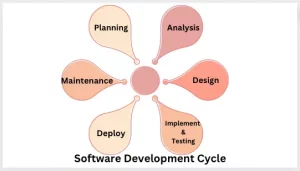
- Planning:
This is the initial phase where the project scope is defined, goals are established, and the project team is formed.
- Requirements Analysis:
In this phase, the project team gathers information from stakeholders and users to identify the system requirements. They recognize the features, functions, and specifications that the software needs to meet.
- Design:
The system architecture is designed in this phase, and the software’s overall structure is established. Designers determine how the software will look, feel, and function.
- Implementation:
Writing code, setting up software components, and integrating third-party libraries are all part of the implementation phase. The design specifications are used by developers to make software.
- Testing:
This is where the software is tested to ensure it meets the requirements and works correctly. Different types of testing, such as unit testing, integration testing, and system testing, are performed to ensure that the software is of high quality.
- Deployment:
The software is released to the end users in this phase. The deployment process may involve installation, configuration, training, and support.
- Maintenance:
Once the software is deployed, it is maintained by fixing bugs, updating features, and ensuring that it continues to meet user requirements. Maintenance is an ongoing process that occurs throughout the software’s lifespan.
It’s important to note that the SDLC process is sometimes linear, and some phases may overlap or be repeated depending on the project’s needs.
Also Read : What is Agile Software Development?
Software Development Life Cycle Models
There are various Software Development Life Cycle (SDLC) models that can be used to guide the development process. Some of the most common models include:
- Waterfall model:The development process progresses linearly through sequential phases (such as requirements gathering, design, implementation, testing, and maintenance).
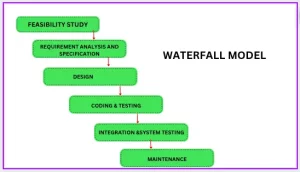
- The Waterfall Model is so called because each phase of the SDLC flows downward, like a waterfall, from one phase to the next, and no phase begins until the previous phase is complete.
- The Waterfall Model typically consists of the following phases, which are performed in a linear, sequential order:
- Requirements gathering and analysis
- Design
- Implementation
- Testing
- Deployment
- Maintenance
- Each phase of the Waterfall Model must be completed before the next step can begin. This means that the requirements must be fully defined before the design can begin, and the design must be complete before implementation can begin, and so on.
- The Waterfall Model is often used for large-scale projects with well-defined and stable requirements. The software development process can be planned and executed with minimal changes or uncertainty.
- However, the Waterfall Model can be inflexible and can result in lengthy development times if changes are needed during the development process. As a result, other SDLC models, such as the Agile Model, have become more prevalent in recent years.
- Agile model:
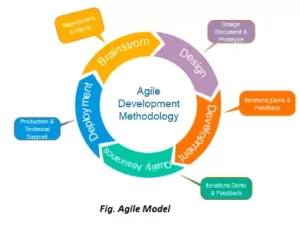
Source: www.javatpoint.comThis model emphasizes collaboration, flexibility, and rapid iteration. Development is broken down into small, iterative cycles (sprints), with frequent feedback and adaptations to changing requirements.- One kind of software development life cycle (SDLC) model that prioritizes adaptability, customer involvement, and ongoing improvement is called the Agile Model.
- The Agile Manifesto, a collection of ideals and guidelines for software development, forms the model’s foundation. It prioritizes people and their interactions, functional software, customer collaboration, and adapting to change.
- According to the Agile Model, the development process is divided into brief iterations known as sprints, each lasting a few weeks.
- The development team works on a particular set of features or requirements during each sprint, and after the sprint, the customer offers input on the work that has been completed. The product is improved, and the upcoming sprint is planned using the feedback received.
- The Agile Model prioritizes the delivery of functional software as soon as feasible and is distinguished by high teamwork and communication.
- The model offers flexibility and adaptability in response to modifications in the requirements or the development environment. It works well for projects with uncertainty or quickly changing needs.
- Software developers frequently employ the Agile Model, especially when creating web and mobile applications.
- Spiral model:
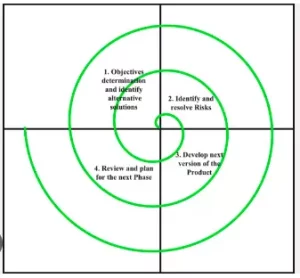 Source: www.geeksforgeeks.comThis model combines elements of the waterfall and agile models, emphasizing risk analysis and continuous iteration. The Spiral Model is a software development life cycle (SDLC) model characterized by a series of iterations or cycles.
Source: www.geeksforgeeks.comThis model combines elements of the waterfall and agile models, emphasizing risk analysis and continuous iteration. The Spiral Model is a software development life cycle (SDLC) model characterized by a series of iterations or cycles.
- It is called the Spiral Model because of the way the model spirals through the phases of the SDLC, with each cycle representing a complete iteration of the process. The Spiral Model includes four main steps: Planning, Risk Analysis, Engineering, and Evaluation.
- Project risks are identified, and objectives are specified during the planning phase. The risks are examined during the Risk Analysis phase, and strategies are created to reduce or eliminate them.
- The software development occurs during the Engineering phase, and as the Spiral Model iterates, a more polished and comprehensive product is produced. Ultimately, the software is assessed to ensure it satisfies user requirements during the evaluation phase.
- The Spiral Model is a valuable tool for projects with a high level of risk or uncertainty, where it is necessary to continuously evaluate and refine the design throughout the development process.
- The model makes more adaptability and flexibility to modifications in the requirements or the development environment possible. Seeing possible issues early on in the process can help reduce risk.
- V-model:
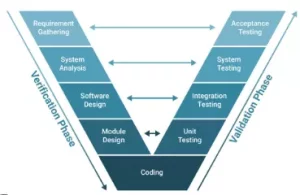 Source: Vector StockThis model emphasizes the importance of testing throughout the development process, with testing activities parallel to each stage of the waterfall model.
Source: Vector StockThis model emphasizes the importance of testing throughout the development process, with testing activities parallel to each stage of the waterfall model.
- It is called the V-Model because of the shape of the diagram, which resembles a “V.” • Each phase of the development process has a corresponding testing phase, with testing occurring at each stage.
- The V-Model includes phases such as Requirements Gathering, Design, Implementation, and Testing.
- Each phase has a corresponding testing phase, such as Requirements Testing, Design Testing, Implementation Testing, and Acceptance Testing.
- The V-Model is a valuable model for projects with a heavy emphasis on testing, where defects must be caught early in the development process to reduce the cost of fixing them later.
- Iterative model:
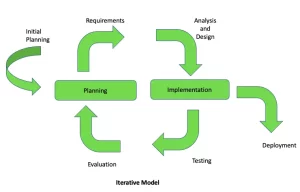 This model involves multiple development and testing cycles, with each cycle building on the previous one until the final product is delivered.
This model involves multiple development and testing cycles, with each cycle building on the previous one until the final product is delivered.
- With this model, several testing and development cycles build upon each other until the finished product is produced.
- A software development life cycle (SDLC) model called the Iterative Model is predicated on repeating tasks until the intended software is created.
- According to this model, software is created in brief bursts, referred to as iterations or increments, and each one is given to the client for evaluation and input.
- The process is repeated until the final software is developed, incorporating the customer’s feedback into each iteration.
- Throughout the development process, the customer’s needs and preferences may change, and the iterative model allows for flexibility and continuous improvement.
Benefits of Software Development Life Cycle (SDLC)
There are several benefits of following a well-defined Software Development Life Cycle (SDLC):
- Better Quality:
A structured SDLC process ensures that software development is done with a focus on quality, resulting in fewer defects and better overall product quality.
- Increased Efficiency:
SDLC helps to streamline the development process, reducing development time, effort, and cost. It ensures that all activities are completed efficiently and that there is no duplication of effort.
- Risk Management:
The SDLC process helps to identify and manage project risks and dependencies, making it easier to manage the project and reducing the likelihood of project failure.
- Improved Communication:
The SDLC creates a transparent communication channel amongst stakeholders, guaranteeing that everyone is informed about the status and evolution of the project.
- Flexibility and Adaptability:
The SDLC process can be modified to accommodate evolving business needs, technological advancements, and project requirements. It enables the development team to take an agile and adaptable approach.
Better software development outcomes, higher customer satisfaction, and a more successful project are the outcomes of implementing SDLC best practices.
SDLC Best Practices
SDLC best practices that can help ensure a successful software development project:
- Plan and define the project scope, goals, and objectives in detail before starting the development process.
- Involve stakeholders and users throughout the development process to ensure their needs are met.
- Use an appropriate SDLC model that suits the project requirements, and adhere to it consistently.
- Break the development process into more miniature, manageable stages, and set realistic milestones and timelines for each stage.
- Ensure that quality is a priority throughout the development process, with clear quality assurance and testing procedures in place.
- Continuously monitor and evaluate the project’s progress to ensure that it remains on track and that any issues are identified and addressed early.
- Keep documentation and communication channels clear and concise throughout the development process, and encourage collaboration and communication between team members.
- Ensure all code is version-controlled and maintainable, with clear documentation and proper backups.
- Conduct regular reviews and retrospectives to assess project performance and identify areas for improvement.
- Learn from past projects and incorporate lessons learned into future SDLC processes.
Case Study on SDLC
The extensive global involvement of Mitsubishi Motors’ suppliers and partners makes for a complicated and information-heavy supply chain. Over the years of operation, the old supply chain had accumulated some noticeable frictions that resulted in efficiency bottlenecks. Because of this, timely improvements are essential to the smooth operation of the entire organization.
Their consultant developed the right set of solutions to make enough to help Mitsubishi ensure a clear line of communication and cooperation with all the suppliers involved.
Problem: The system required careful research and data collection to work with complex and multi-layered legacy systems like the one Mitsubishi uses.
Data Collection: The team of the consultant collected all the data. They collected and gathered all the data, tracking all the issues related to the functioning of legacy systems. The skilled employees then outlined the necessary solution and allocated the resources to attain project’s goals.
Design: Once all the necessary requirements were collected, the consultants and teh software developers for Mitsubishi commenced the design phase by considering all of Mitsubishi’s specifications and developed several solutions aligned with their needs. These solutions included a user-friendly data model to reduce data redundancy, a permission system that distinguished users by their access levels, a visually appealing user interface mockup to enhance user experience, integration with the existing RPG system, and notifications to keep partners updated on essential activities.
Solution Development: The developers created a user-friendly data model that minimizes the chances of human error by reducing repetitive data entry and duplication. Additionally, the team improved the security system for Mitsubishi’s users, enabling them to have the appropriate control over the data based on their access level. Developers also added a notification feature to quickly help users respond to relevant changes. Furthermore, the user interface was designed to be visually appealing and easy to use, utilizing the AJAX framework to streamline the user-system interaction. The platform was deployed on an IBM AS400 server, integrated with DB2 databases, and the existing RPG software was incorporated into the new system. Furthermore, all necessary data, including existing spreadsheets, were migrated to the new system.
Quality Assurance: Working for the reputed motor manufacturer, quality assurance was a must just like any other industry segment. The developer team aimed at removing bugs and optimizing the software.
Integrate and Support: The system software was integrated with the existing work platform. A complex mechanism was made simple. The developer team was available to provide complete support.
Final Word
The Software Development Life Cycle (SDLC) is a trusted method for structured software development, ensuring high-quality results through best practices and stakeholder involvement. Implementing SDLC optimizes processes, minimizes errors, and saves resources. For software development assistance, contact us at hello[at]noboruworld.com
FAQ’s
What is the first step in software development life cycle?
Usually, the Planning phase is the first step in Software Development Life Cycle (SDLC). In this stage, the team is put together, the goals and objectives are set, and the project scope is clarified. The group strives to comprehend user, stakeholder, and client needs and requirements. The development process is guided by a project plan that comprises budgets, schedules, and resource allocation. Assuring that the project aligns with the business goals and laying the groundwork for a fruitful development process depends heavily on the planning phase.
The Software Development Life Cycle (SDLC): What is it?
Software developers use a methodical process called the Software Development Life Cycle, or SDLC, to design, develop, test, and release high-quality software. It includes requirements collecting, organizing, coding, testing, deploying, and maintaining, among other phases. The objective is to create dependable software that satisfies business and user needs.
Why is Testing an Integral Part of the SDLC?
It is essential because testing finds and fixes errors early in the software development life cycle. It facilitates a more seamless deployment by guaranteeing the software’s dependability and functionality. User acceptability testing, system testing, integration testing, and unit testing are all types of testing. Developers can lower the overall cost of development and improve the overall quality of the software by thoroughly testing each stage to identify problems before they intensify.
How does Agile Differ from Traditional SDLC Models?
Agile is a modern approach to software development that differs from traditional SDLC models like Waterfall. While conventional models follow a linear and sequential path, Agile is iterative and emphasizes flexibility and collaboration. Agile breaks the development process into small, manageable sprints, allowing for frequent reassessment and adaptation. This iterative approach enhances responsiveness to changing requirements and promotes continuous improvement throughout the development cycle.



